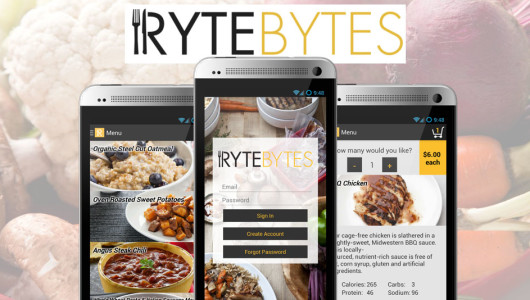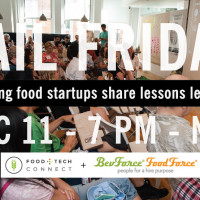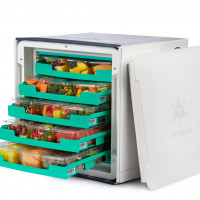Last Spring, Geoff Gustitus and Nick McMillan made the trek to NYC to take part in our Food Startup Branding 101 Bootcamp. The pair was in the process of launching RyteBytes, a kiosk for customizable pre-cooked meals with an accompanying ordering app, i.e. a Redbox for healthy meals.
Geoff and Nick had been testing their menus and refining their product. They were using chest freezers for meal distribution and were prototyping a custom kiosk when they attended the bootcamp. But just a few months after taking the course, Nick and Geoff decided to pull the plug on RyteBytes, because the up-front costs of building the kiosks were much higher than they’d initially expected.
We asked the co-founders to share their story and lessons learned to help our community understand what’s working and what’s not for other startups. In our food startup case study below, they dive into why they wish they had focused on branding from the start, how the skills they gained in the bootcamp helped propel RyteBytes before they ultimately decided to move on and why they think the lean startup model isn’t always the way to go. They also dish out some heartfelt advice for how entrepreneurs can learn from failure and stay optimistic.
Also, check out our first food startup branding case study with menu discovery-turned-mobile payment app HotSauce here.
Fundamentals of User Research and Food Startup Branding 101 are now available online. Check them out and join our learning community if you want to take your brand to the next level.
________________
Food+Tech Connect: Why did you sign up for Food Startup Branding 101, and what skills were you looking to gain?
Nick McMillan: Neither of us had experience in marketing or branding, which, for a consumer packaged goods company, is vitally important. So the opportunity to build, or at least get an introduction to the marketing and branding skills and framework of thinking was an opportunity we couldn’t pass up. We were super excited to get that knowledge and to meet not only [instructors] and learn what they had to say, but also to meet and network with other food tech entrepreneurs, because they had the same issues.
FTC: Can you share a specific example of that problem solving and/or knowledge sharing you found so valuable?
NM: The biggest thing that I can say is the idea of cohesion. That everything from your tone on social media, to the tone of your writing, to the ads that you use, to your packaging should all be cohesive. That was something that I hadn’t really thought about. The course and everything that we learned was the catalyst for searching out people to help us refine our brand and make it shareable across social media. It led us to talking to someone about developing packaging and labeling and ensuring that it was consistent.
FTC: You recently decided to pull the plug on RyteBytes because the kiosk infrastructure was cost prohibitive. What were your key lessons learned from this process and coming to that decision?
GEOFF GUSTITUS: I think first is that when you’re beginning a business, you have to be very, very cognizant of the external environment in which you’re entering, because though your business itself may be B-to-C, in many circumstances, you [can be] entirely dependent on the rest of that space and the players that operate in it. The companies that we were dealing with for the kiosks, while very good at what they do, that industry itself does not mesh well with a lot of the things that we were going for. One of the key surprises was that the technologies that the kiosk companies were using were fairly antiquated. And not just that, but they were fairly reluctant to take a more entrepreneurial mindset to opening themselves up to new product lines. They have a very, very mature industry. So in that particular vein, it was difficult to get people to branch outside of what they had already been doing.
NM: The vast majority of vending machines are going to be selling snacks and pop, and so there’s not a lot of need for new innovation. So when new ideas come along, the cost to develop them is extremely high. And one of the other lessons is that we tried to do things as lean as possible. And I think we applied that to too much of the business. It kind of pulled us away from progress on the core ideas, and we should’ve been a little more open to spending money or resources on areas where we needed help. We participated in the branding bootcamp in March, but we’d already been around for a year and a half. So I think if we had learned the lessons that we took from the workshop in March, that would’ve helped accelerate sales a little bit. Our lesson learned was that it’s better to spend the resources that you have in your weakest areas. That’s definitely something we lived through, and now looking back on it we understand.
FTC: How do you think having a cohesive brand strategy helped you face your challenges with RyteBytes?
NM: One of the biggest things I think for us specifically was that in an era where fresh has really dominated, where it’s all about fresh and farm-to-table, we were selling a frozen product. People were always skeptical whenever we would go out and do a demo, until they tasted it. Getting over that initial skeptical hump was where that cohesive brand strategy was going to be critical in finding a way to tell our story and sell the product in a way that helped us mitigate that initial skepticism. And that was the driving reason for participating in the bootcamp, to learn at least how to attack that problem. And there was a lot of good info in the bootcamp to help us.
FTC: Do you think that the branding knowledge you gainedhelped you deal with the decision to move on?
NM: After the bootcamp was really when we acknowledged that we were a food company. We were trying to build an expensive, kind of unique vending solution – but we had been so focused on that and the technology side that we really lost perspective on the fact that we were first and foremost a food company. I don’t think it was a conscious thing that we came back and said, “Oh, after that, we’re a food company,” but it shifted our thinking to “We need to start packaging and branding ourselves as food, as convenience.”
FTC: Do you have any advice for how entrepreneurs can stay optimistic and grow from failures?
GG: Honestly, a lame answer, but advice is a dime a dozen. It’s really best to just dive in and learn it all for yourself. There’s so much information out there, and there’s so much advice. And not just for entrepreneurs generally, but even really getting down into the detail of the food and tech space. It exists, and it’s really good – especially if they have Food+Tech Connect. You guys were very helpful with bringing us all together. I guess the only piece of advice would be to lean on those that have additional resources and knowledge available, and really engage in the community overall. Because you rarely can do anything in a vacuum.
NM: The only thing that I have to add is definitely embrace the small or big wins that you encounter. Starting a company is a rollercoaster, and I think that’s fairly accurate. So enjoying and relishing the wins, the ups, to help carry you through the lower points is super huge. And I absolutely agree with leaning on and helping others in your space, because you’re all kind of in it together. That was really one of the great things about the food branding workshop: meeting with other food entrepreneurs and engaging with them, seeing what problems they [face], sharing your thoughts and problems and really collecting that knowledge and making it so that other people can easily access it.






